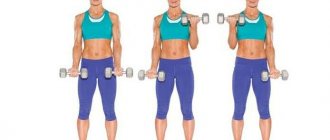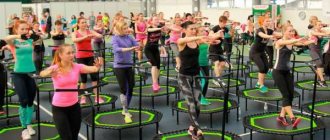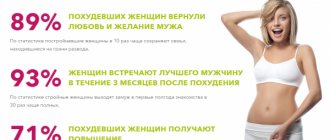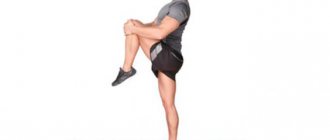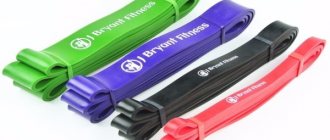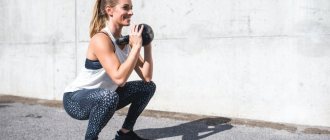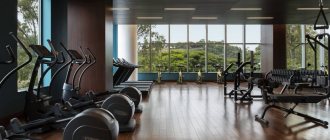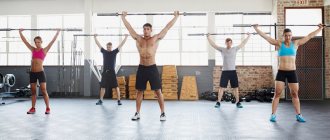Being a young mother is an unforgettable experience; it brings many new emotions and impressions. Constantly being alone with the baby and following a daily routine can be difficult psychologically and physically for a new mother, but thanks to modern technology, life with a newborn is quite easy to arrange. Just a few weeks after giving birth, more and more young girls are trying to find time for themselves. Exercises with a child in your arms are an excellent way to maintain a good appearance and a cheerful mood.
Choosing a class time
It is recommended to start doing the simplest exercises aimed at training the pelvic floor muscles, or Kegel exercises, already in the maternity hospital. Squeezing and unclenching the internal muscles of the vagina helps prevent problems with urination and restores the muscles of the uterus, stretched after pregnancy and childbirth.
sports exercises for a mother with an infant no earlier than 6-8 weeks after birth, if they passed without pathology. In case of cesarean section, heavy bleeding or other complications, it is better to postpone gymnastics until you consult a gynecologist or your doctor.
Fitness exercises should be carried out provided that both mother and baby are in good health. Her goal is not only to restore the female figure after childbirth, but also to enjoy the time spent with the baby.
The best time to play sports with a baby in your arms is the period from 3 to 12 months of the baby . A baby at this age is already strong enough for a little joint gymnastics. It can serve as a weight for exercises with loads and at the same time it does not move too confidently and can be fixed in the position that is required.
You should not deal with the baby immediately after feeding, so as not to cause regurgitation; it is better to wait 40-45 minutes.
Naturally, the baby should be active and alert while charging. If the baby is naughty or falls asleep, you will have to choose a different time for training or wait until he sleeps and do the exercises yourself.
Benefits for both
Mom and baby receive mutual benefits:
- The mother goes in for sports, and the child will not be left unattended.
- During training, the baby becomes a natural load for the mother, the weight of which gradually increases. This is important for the recovery of the body, especially after a caesarean section.
- The connection between a woman and her loved one is strengthened.
- The child gets used to training and gains experience communicating with peers.
- Mom’s movements: rocking, bending, turning, changing tempo contribute to the development of the baby’s gross motor skills, coordination, and vestibular apparatus.
Fitness with children allows you to recover after childbirth, evokes positive emotions, and brings mother and child closer together. You need to trust your maternal instinct, listen to yourself, and then the expected changes will not keep you waiting.
Fitness rules for mothers with children
Carrying out home sports activities for mothers and babies requires following simple rules:
- The mother's movements should be soft and smooth, so as not to scare or harm the baby.
- It is forbidden to run and jump with a child in your arms due to the high load on the baby’s spine when shaking.
- The child must be supported and secured to prevent him from falling during training (babies up to 3-4 months should be supported by the head, then held by the arms).
- If the baby cries, home exercises should be completed and calmed down.
- You should start with a minimum number of approaches, gradually increasing the load.
- Physical training should bring joy and satisfaction, not fatigue.
Rules for performing gymnastics for newborns
Charging for newborns up to a month should be carried out with the utmost care.
The most important principle of gymnastics for babies is to do no harm.
Therefore, when performing it, it is necessary to follow certain rules.
Namely:
- Before starting the exercises, you should ventilate the room well and let it warm up for fifteen minutes.
- All exercises must be performed on a flat and hard surface so that the baby’s spine develops correctly. A changing table is ideal for these purposes.
- When performing a light massage of the baby's body, movements should be made in the direction from the limbs to the center of the body.
- When stroking the back of a newborn, under no circumstances should you put pressure on the area of the kidneys and heart.
- The recommended duration of the exercise set is ten minutes.
- Negative emotions on the part of the baby, as well as any forced actions, are unacceptable.
- If the baby cries and is capricious, the start of gymnastics classes should be postponed to a more favorable period.
Exercises with a child in your arms
You should start your fitness classes with a warm-up in the form of a quick step or jumping in place, dancing to your favorite music. It is better to carry out this part of the training without the child, leaving him in a crib or other safe place (on the floor, in the playpen). After 4-5 months, the baby will follow with interest the actions of the mother, which will benefit the development of his attention and observation.
You can turn on the music and dance with your child, moving smoothly and calmly.
Fitness for mothers with babies includes exercises for various muscle groups, but the main focus is on the abs, abdomen, and buttocks as the areas most affected during pregnancy. You should also not forget about back exercises, since carrying a baby in your arms for a long time puts a serious strain on the spine.
Initially, any exercise is performed with a minimum number of approaches. The increase in load should be gradual and not lead to overwork. In case of discomfort or pain, especially in the lower abdomen, exercise should be stopped.
Abdominal exercises
Abdominal exercises can be performed no earlier than 2-3 months after the baby is born. If there are surgical scars, the date for starting classes is recommended by the doctor; violating it is dangerous due to the risk of sutures coming apart.
- Starting position: lying on your back, legs bent at the knees, the child lies on the mother’s stomach or sits, leaning on his hips as if on the back of a chair. Mom raises her head, lifting her shoulder blades and shoulders off the floor, and tries to reach her knees. This is a classic abdominal exercise with the only difference being that there is a baby on the woman’s body.
- Lying on your back, bend your knees and press them to your chest. Place the child on his shins parallel to the floor. In this position, try to lift your head and shoulders off the floor, straining your buttocks, folding even more.
Exercises for the buttocks and thighs
- Squat with the baby on your neck or in a sling.
- Rock the baby on your shin, sitting in a “leg to leg” position, while at the same time you can recite a nursery rhyme or a nursery rhyme.
- Lie on your back, bend your knees 90 degrees and place your feet on a sofa or low chair. Place the baby on your stomach, holding it, lift your buttocks, stretching your body in one line. Hold the position for 3 seconds and, relaxing, lower to the floor.
- Lunges with a child in your arms. Alternately stand on the knee of your right and left legs, holding the baby upright, tightly pressed to you.
4.3. Educational and information support for the program
Educational and professional literature for this practice:
1. Aerobics. Theory and methods of conducting classes: Textbook for students of physical education universities / Ed. E. B. Myakinchenko, M. P. Shestakova. M.: SportAkademPress, 2002.
2. Basic aerobics in health fitness: textbook. benefit / Planet fitness. – M.: UIC VEK LLC, 2006.
3. Begidova T. P. Theory and organization of adaptive physical culture. M.: Yurayt, 2022.
4. Buts, L.M. For you girls / L.M. Butz - M. Physical education and sports, 1988
5. Weindorf-Sysreva, M. E. Methods of distance learning: a textbook for universities / M. E. Weindorf Sysoeva, T. S. Gryaznova, V. A. Shitova; under the general editorship of M. E. Weindorf-Sysoeva. — Moscow: Yurayt Publishing House, 2020
6. Davydov, V.Yu., Kovalenko, T.G., Krasnova, G.O. Methods of teaching health aerobics / Dovydov V.Yu., Kovalenko T.G., Krasnova G.O. – Volgograd: Publishing house Volgogr. state un-ta. – 2004
7. Ivanova O.A., Dikarevich L.M. Aerobics plus strength and flexibility: physical education for everyone // Health. 1993
8. Kryuchek, E.S. Aerobics. Contents and methods of conducting health-improving classes / E.S. Hook. – M.: Terra-Spor, Olympia Press, 2001.
9. J.E. Firileva, E.G. Saikina, 2007 “Fitness dance” St. Petersburg “Childhood-press” 2001
10. Firilyova Zh.E., Saikina E.G. Therapeutic and prophylactic dance “Fitness Dance”, textbook St. Petersburg, “Childhood-press” 2007.
11. Yagodin V.V. Physical culture. Fundamentals of sports ethics. M.: Yurayt, 2022.
Regulatory acts and documents:
· Federal Law of December 29, 2012 No. 273-FZ “On Education in the Russian Federation”;
· Concept for the development of additional education for children until 2030 (draft);
· Concept for the development of additional education for children (approved by Decree of the Government of the Russian Federation dated September 4, 2014 No. 1726-r);
· Methodological recommendations for the design of additional general developmental programs (including multi-level programs): appendix to the letter of the Ministry of Education and Science of the Russian Federation dated November 18, 2015 No. 09-3242;
· The procedure for organizing and implementing educational activities in additional general education programs (approved by Order of the Ministry of Education and Science of the Russian Federation dated November 9, 2022 No. 196);
· Order of the Ministry of Labor and Social Protection of the Russian Federation dated September 8, 2015. No. 613-“On approval of the professional standard “Teacher of additional education for children and adults”;
· Methodological recommendations for the design of additional general developmental programs (including multi-level programs): appendix to the letter of the Ministry of Education and Science of the Russian Federation dated November 18, 2015 No. 09-3242;
· SanPiN 2.4.1.3049-13 “Sanitary and epidemiological requirements for the structure, content and organization of the operating mode of preschool educational organizations” (approved by the Decree of the Chief State Sanitary Doctor of the Russian Federation dated May 15, 2013 No. 26);
· SanPiN 2.4.4.3172-14 “Sanitary and epidemiological requirements for the structure, content and organization of the operating mode of educational organizations for additional education of children” (approved by the Decree of the Chief State Sanitary Doctor of the Russian Federation dated July 4, 2014 No. 41);
· Order of the Moscow Department of Education dated December 17, 2014 No. 922 “On measures to develop additional education for children in 2014-2015” (with amendments and additions);
· Charter of the state budgetary educational institution of additional education “Zelenograd Palace of Children and Youth Creativity”;
· Order of GBOUDO ZDTiM dated January 16, 2018 No. 5 “On approval of the “Regulations on the procedure for the development and implementation of an additional general development program in GBOUDO ZDTiM”;
· Order of GBOUDO ZDTiM dated August 31, 2020 No. 119-04.1-04/20 “On approval of the “Regulations on the procedure for the development and implementation of an additional general development program in GBOUDO ZDTiM”;
· Order of the State Budget Educational Institution of Education and Science of the Russian Federation of 06/14/2017 “On approval of the “Regulations on the forms, frequency and procedure for ongoing monitoring of academic performance and certification of students of the State Budgetary Education and Institution of Education and Science of the State Budgetary Educational Institution of Education and Science of the Russian Federation”;
· Order of GBOUDO ZDTDiM No. 119-04.1 -04/20 dated 08/31/2020 “On approval of the “Regulations on the procedure for the development and implementation of an additional general development program in GBOUDO ZDT&M”;
· Order of GBOUDO ZDTiM No. 126-04.1-04/20 dated August 31, 2020 “On approval of the “Regulations on the forms, frequency and procedure for ongoing monitoring of progress and certification of students of GBOUDO ZDTiM.”
Internet resources : _
· https://www.youtube.com/watch?v=vFu98SvyGig
· https://www.youtube.com/watch?v=ZHKcGEDp4EA
· https://www.youtube.com/watch?v=mFH7mRc5p-M
· https://www.biblio-online.ru/bcode/450836
Fitness for moms in the pool and gym
You can train with your baby both at home and in a special room.
Many fitness centers offer similar services for mothers with children over 3 months old . Classes in the gym are conducted under the guidance of an experienced trainer and include a full range of exercises for losing weight and restoring the body after pregnancy. Postpartum gymnastics has a beneficial effect on a woman’s health and gives her vitality.
Attending such classes is a great way to get in shape, be physically active, make new friends and expand your social circle.
A popular type of physical activity with a baby is baby yoga. This is a set of asanas selected for women after childbirth and performed together with their babies. The older children are, the more actively they become involved in yoga practice. During training, mainly static poses are used, which alternate with rest. This activity will not only put your body in order, but will also teach you how to properly relax and distract yourself from the hustle and bustle of everyday life.
A significant disadvantage of training in a specialized center is the need to visit a public space at a certain time. In young children, their immunity is still developing and they can easily be susceptible to viruses. In addition, the periods of sleep and wakefulness of babies up to 3-4 months are just being established, so it may be difficult to synchronize training and daily routine. It is also important that the road to the center is not tiring for either mother or baby.
An alternative to fitness can be swimming. Special classes for mothers with babies are held in many swimming pools. Many children under one year old enjoy swimming and can easily learn to dive if they regularly attend classes. Staying in cool water helps strengthen the immune system, strengthening, physical development and restful sleep of the baby after training. When choosing a pool, you should pay attention to the quality and method of water purification, the availability of conditions for babies (changing tables, playpens). Classes must be taught by a certified instructor.
4.2. Material and technical conditions for the implementation of the program
For the successful implementation of this program, the following conditions and equipment are required:
· dance hall equipped with dance flooring and mirrors;
· music center with storage media;
· special clothing and shoes for dance fitness classes.
· equipment for viewing video materials.
· individual mats for classes on the ground;
· sports equipment: balls, jump ropes, gymnastic sticks.
Lessons on the street
In the warm season, you can do gymnastics while walking while the baby sleeps in a stroller . At the first stage, it is enough to alternate fast and slow walking paces, roll from toe to heel, walk on tiptoes and goose step. You can practice leg swings, try to do “swallows” and squats, if your physical fitness allows.
Don't forget about your hands. Although carrying a child in your arms in itself stimulates the development of the muscles of the shoulder girdle, it is worth adding unloading exercises: rotating your arms in a circle, squeezing your clasped hands while holding your elbows at chest level. The last task also helps prevent milk stagnation during breastfeeding.
Some models of strollers allow you to go for a full run when walking with your baby. For such training, you need to choose smooth paths away from highways in order to minimize the child’s shaking. You should pay attention to the stability of the stroller when turning.
At the dacha or in your own home, you can do all the same exercises as at home, while being outside, combining the benefits of physical activity with being in the fresh air.
3.1. Educational and thematic plan
| № | Section title | Number of hours | Forms of certification (control) | |||
| Total | Practice | Theory | ||||
| 1. | Introductory lesson | Safety talks | 1 | 0,5 | 0,5 | conversation |
| 2. | Elementary dance fitness movements | Walking, running and locomotion | 8 | 7 | 1 | pedagogical observation |
| Jumping | 8 | 7 | 1 | pedagogical observation | ||
| 3. | general physical training | Hand exercises | 8 | 7 | 1 | pedagogical observation |
| Leg exercises | 8 | 7 | 1 | pedagogical observation | ||
| Exercises for the neck and back | 8 | 7 | 1 | pedagogical observation | ||
| 4. | Dance and game rhythms | Musical and outdoor games | 10 | 9 | 1 | pedagogical observation |
| Dance-rhythmic exercises | 10 | 9 | 1 | pedagogical observation | ||
| Dance- gaming creation | 10 | 9 | 1 | pedagogical observation | ||
| 5. | Final lesson | Open lesson | 1 | 0,5 | 0,5 | open lesson |
| Total: | 72 | 63 | 9 | |||
How to prepare your baby for walking
The walking reflex is developed in infants at the age of several days. The task of parents is to correctly develop this reflex.
To do this, you should put the baby in an upright position so that his legs are on a hard surface - in this way, he will begin to take his first small steps on an intuitive level.
However, if the baby does not feel such a desire, you can help him with this by slightly tilting his torso and head forward.
It is important that the baby’s entire foot is on the surface. This position will certainly encourage the baby to walk.
Proper gymnastics promotes the harmonious development of the physical and intellectual sphere of the newborn. The main thing is that the exercises are regular and bring the baby only joy and pleasure.
